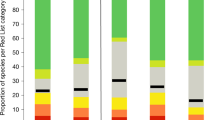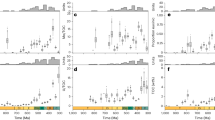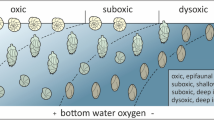Abstract
Planetary boundaries represent thresholds in major Earth system processes that are sensitive to human activity and control global-scale habitability and stability. These processes are interconnected such that movement of one planetary boundary process can alter the likelihood of crossing other boundaries. Here we argue that the observed deoxygenation of the Earth’s freshwater and marine ecosystems represents an additional planetary boundary process that is critical to the integrity of Earth’s ecological and social systems, and both regulates and responds to ongoing changes in other planetary boundary processes. Research on the rapid and ongoing deoxygenation of Earth’s aquatic habitats indicates that relevant, critical oxygen thresholds are being approached at rates comparable to other planetary boundary processes. Concerted global monitoring, research and policy efforts are needed to address the challenges brought on by rapid deoxygenation, and the expansion of the planetary boundaries framework to include deoxygenation as a boundary helps to focus those efforts.
This is a preview of subscription content, access via your institution
Access options
Access Nature and 54 other Nature Portfolio journals
Get Nature+, our best-value online-access subscription
$32.99 / 30 days
cancel any time
Subscribe to this journal
Receive 12 digital issues and online access to articles
$119.00 per year
only $9.92 per issue
Buy this article
- Purchase on SpringerLink
- Instant access to full article PDF
Prices may be subject to local taxes which are calculated during checkout


Similar content being viewed by others
References
Rockström, J. et al. A safe operation space for humanity. Nature 461, 472–475 (2009).
Steffen, W. et al. Planetary boundaries: guiding human development on a changing planet. Science 347, 1259855 (2015).
Richardson, K. et al. Earth beyond six of nine planetary boundaries. Sci. Adv. 9, eadh2458 (2023).
Rockström, J. et al. Safe and just Earth system boundaries. Nature 619, 102–111 (2023).
Lade, S. J. et al. Human impacts on planetary boundaries amplified by Earth system interactions. Nat. Sustain. 3, 119–128 (2020).
Ferrer, E. Climate–Fishery Interactions in Coastal Ecosystems. Thesis, Scripps Institute of Oceanography, UC San Diego, 6–47 (2023).
Raymond, J. & Segrè, D. The effect of oxygen on biochemical networks and the evolution of complex life. Science 311, 1764–1767 (2006).
Fang, J. Animals thrive without oxygen at sea bottom. Nature 464, 825 (2010).
Scott, A. C. & Glasspool, I. J. The diversification of Paleozoic fire systems and fluctuations in atmospheric oxygen concentration. Proc. Natl Acad. Sci. USA 103, 10861–10865 (2006).
Falkowski, P. G. et al. The rise of oxygen over the past 205 million years and the evolution of large placental mammals. Science 309, 2202–2204 (2005).
Poulsen, C. J., Tabor, C. & White, J. D. Long-term climate forcing by atmospheric oxygen concentrations. Science 348, 1238–1242 (2015).
Pohl, A. et al. Continental configuration controls ocean oxygenation during the Phanerozoic. Nature 608, 523–527 (2022).
He, T. et al. Possible links between extreme oxygen perturbations and the Cambrian radiation of animals. Nat. Geosci. 12, 468–474 (2019).
Kraft, B. et al. Oxygen and nitrogen production by an ammonia-oxidizing archaeon. Science 375, 97–100 (2022).
Kreling, J. et al. The importance of physical transport and oxygen consumption for the development of a metalimnetic oxygen minimum in a lake. Limnol. Oceanogr. 62, 348–363 (2017).
Stramma, L. et al. Expansion of oxygen minimum zones may reduce available habitat for tropical pelagic fishes. Nat. Clim. Change 2, 33–37 (2012).
Mi, C. et al. The formation of a metalimnetic oxygen minimum exemplifies how ecosystem dynamics shape biogeochemical processes: a modelling study. Water Res. 175, 115701 (2020).
Smith, K. L., Messié, M., Connolly, T. P. & Huffard, C. L. Decadal time‐series depletion of dissolved oxygen at abyssal depths in the northeast Pacific. Geophys. Res. Lett. 49, e2022GL101018 (2022).
Diaz, R. J. & Rosenberg, R. Spreading dead zones and consequences for marine ecosystems. Science 321, 926–929 (2008).
Jane, S. F. et al. Widespread deoxygenation of temperate lakes. Nature 594, 66–70 (2021).
Brune, A., Frenzel, P. & Cypionka, H. Life at the oxic–anoxic interface: microbial activities and adaptations. FEMS Microbiol. Rev. 24, 691–710 (2000).
Huang, J. et al. The global oxygen budget and its future projection. Sci. Bull. 63, 1180–1186 (2018).
Jenny, J. P. et al. Global spread of hypoxia in freshwater ecosystems during the last three centuries is caused by rising local human pressure. Glob. Change Biol. 22, 1481–1489 (2016).
Schmidtko, S., Stramma, L. & Visbeck, M. Decline in global oceanic oxygen content during the past five decades. Nature 542, 335–339 (2017).
Breitburg, D. et al. Declining oxygen in the global ocean and coastal waters. Science 359, eaam7240 (2018).
Limburg, K. E., Breitburg, D., Swaney, D. P. & Jacinto, G. Ocean deoxygenation: a primer. One Earth 2, 24–29 (2020).
Zhi, W., Kligler, C., Liu, J. & Li, L. Widespread deoxygenation in warming rivers. Nat. Clim. Change 13, 1105–1113 (2023).
Levin, L. A. Manifestation, drivers, and emergence of open ocean deoxygenation. Annu. Rev. Mar. Sci. 10, 229–260 (2018).
Ono, T., Watarlabe, Y. W., Tadokoro, K. & Saino, T. Temporal increases of phosphate and apparent oxygen utilization in the subsurface waters of western subarctic Pacific from 1968 to 1998. Geophys. Res. Lett. 28, 3285–3288 (2001).
Keeling, R. F., Körtzinger, A. & Gruber, N. Ocean deoxygenation in a warming world. Annu. Rev. Mar. Sci. 2, 199–229 (2010).
Stramma, L., Schmidtko, S., Levin, L. A. & Johnson, G. C. Ocean oxygen minima expansions and their biological impacts. Deep Sea Res. 1 Oceanogr. Res. Pap. 57, 587–595 (2010).
Grégoire, M. et al. A global ocean oxygen database and atlas for assessing and predicting deoxygenation and ocean health in the open and coastal ocean. Front. Mar. Sci. 8, 724913 (2021).
Jane, S. F. et al. Longer duration of seasonal stratification contributes to widespread increases in lake hypoxia and anoxia. Glob. Change Biol. https://doi.org/10.1111/gcb.16525 (2022).
Vaquer-Sunyer, R. & Duarte, C. M. Thresholds of hypoxia for marine biodiversity. Proc. Natl Acad. Sci. USA 105, 15452–15457 (2008).
Deutsch, C., Ferrel, A., Seibel, B., Pörtner, H.-O. & Huey, R. B. Climate change tightens a metabolic constraint on marine habitats. Science 348, 1132–1136 (2015).
Deutsch, C., Penn, J. L. & Seibel, B. Metabolic trait diversity shapes marine biogeography. Nature 585, 557–562 (2020).
Vaquer-Sunyer, R. & Duarte, C. M. Experimental evaluation of the response of coastal Mediterranean planktonic and benthic metabolism to warming. Estuaries Coasts 36, 697–707 (2013).
Penn, J. L. & Deutsch, C. Avoiding ocean mass extinction from climate warming. Science 376, 524–526 (2022).
Mortimer, C. H. The exchange of dissolved substances between mud and water in lakes. Br. Ecol. Soc. 29, 280–329 (1941).
Wang, S., Jin, X., Bu, Q., Jiao, L. & Wu, F. Effects of dissolved oxygen supply level on phosphorus release from lake sediments. Colloids Surf. A 316, 245–252 (2008).
Hilt, S., Brothers, S., Jeppesen, E., Veraart, A. J. & Kosten, S. Translating regime shifts in shallow lakes into changes in ecosystem functions and services. BioScience 67, 928–936 (2017).
Harris, R. M. B. et al. Biological responses to the press and pulse of climate trends and extreme events. Nat. Clim. Change 8, 579–587 (2018).
O’Reilly, C. M. et al. Rapid and highly variable warming of lake surface waters around the globe. Geophys. Res. Lett. https://doi.org/10.1002/2015GL066235 (2015).
Johnson, G. C. & Lyman, J. M. Warming trends increasingly dominate global ocean. Nat. Clim. Change 10, 757–761 (2020).
Frölicher, T. L., Fischer, E. M. & Gruber, N. Marine heatwaves under global warming. Nature 560, 360–364 (2018).
Woolway, R. I. et al. Lake heatwaves under climate change. Nature 589, 402–407 (2021).
Oliver, E. C. J. et al. Projected marine heatwaves in the 21st century and the potential for ecological impact. Front. Mar. Sci. 6, 734 (2019).
Garçon, V. et al. Multidisciplinary observing in the world ocean’s oxygen minimum zone regions: from climate to fish—the VOICE Initiative. Front. Mar. Sci. 6, 722 (2019).
Wiltse, B., Yerger, E. C. & Laxson, C. L. A reduction in spring mixing due to road salt runoff entering Mirror Lake (Lake Placid, NY). Lake Reserv. Manage. 36, 109–121 (2020).
Cliff, E., Khatiwala, S. & Schmittner, A. Glacial deep ocean deoxygenation driven by biologically mediated air–sea disequilibrium. Nat. Geosci. 14, 43–50 (2021).
Polyakov, I. V. et al. Greater role for Atlantic inflows on sea-ice loss in the Eurasian Basin of the Arctic Ocean. Science 356, 285–291 (2017).
Sharma, S. et al. Widespread loss of lake ice around the Northern Hemisphere in a warming world. Nat. Clim. Change 9, 227–231 (2019).
Woolway, R. I. et al. Phenological shifts in lake stratification under climate change. Nat. Commun. 12, 2318 (2021).
Zhou, J., Leavitt, P. R., Zhang, Y. & Qin, B. Anthropogenic eutrophication of shallow lakes: is it occasional? Water Res. 221, 118728 (2022).
Canadell, J. G. et al. in Climate Change 2021: The Physical Science Basis (eds Masson-Delmotte, V. et al.) Ch. 5 (IPCC, Cambridge Univ. Press, 2021).
Ruvalcaba Baroni, I., Palastanga, V. & Slomp, C. P. Enhanced organic carbon burial in sediments of oxygen minimum zones upon ocean deoxygenation. Front. Mar. Sci. 6, 839 (2020).
Finlay, K. et al. Decrease in CO2 efflux from northern hardwater lakes with increasing atmospheric warming. Nature 519, 215–218 (2015).
Van Cappellen, P. & Ingall, E. D. Redox stabilization of the atmosphere and oceans by phosphorus-limited marine productivity. Science 271, 493–496 (1996).
Oschlies, A., Brandt, P., Stramma, L. & Schmidtko, S. Drivers and mechanisms of ocean deoxygenation. Nat. Geosci. 11, 467–473 (2018).
Niemeyer, D., Kemena, T. P., Meissner, K. J. & Oschlies, A. A model study of warming-induced phosphorus–oxygen feedbacks in open-ocean oxygen minimum zones on millennial timescales. Earth Syst. Dyn. 8, 357–367 (2017).
Landolfi, A., Dietze, H., Koeve, W. & Oschlies, A. Overlooked runaway feedback in the marine nitrogen cycle: the vicious cycle. Biogeosciences 10, 1351–1363 (2013).
Karstensen, J., Stramma, L. & Visbeck, M. Oxygen minimum zones in the eastern tropical Atlantic and Pacific oceans. Prog. Oceanogr. 77, 331–350 (2008).
Codispoti, L. A. Interesting times for marine N2O. Science 327, 1339–1340 (2010).
Beman, J. M. et al. Substantial oxygen consumption by aerobic nitrite oxidation in oceanic oxygen minimum zones. Nat. Commun. 12, 7043 (2021).
Landry, C. A., Steele, S. L., Manning, S. & Cheek, A. O. Long term hypoxia suppresses reproductive capacity in the estuarine fish, Fundulus grandis. Comp. Biochem. Physiol. A Mol. Integr. Physiol. 148, 317–323 (2007).
Brander, K. Reduced growth in Baltic Sea cod may be due to mild hypoxia. ICES J. Mar. Sci. 77, 2003–2005 (2020).
Gallo, N. D. & Levin, L. A. Fish ecology and evolution in the world’s oxygen minimum zones and implications of ocean deoxygenation. Adv. Mar. Biol. 74, 117–198 (2016).
Verberk, W. C. E. P. et al. Body mass and cell size shape the tolerance of fishes to low oxygen in a temperature‐dependent manner. Glob. Change Biol. 28, 5695–5707 (2022).
Chapman, L. J. & Hulen, K. G. Implications of hypoxia for the brain size and gill morphometry of mormyrid fishes. J. Zool. 254, 461–472 (2001).
Kump, L. R., Pavlov, A. & Arthur, M. A. Massive release of hydrogen sulfide to the surface ocean and atmosphere during intervals of oceanic anoxia. Geology 33, 397–400 (2005).
Stockey, R. G., Pohl, A., Ridgwell, A., Finnegan, S. & Sperling, E. A. Decreasing Phanerozoic extinction intensity as a consequence of Earth surface oxygenation and metazoan ecophysiology. Proc. Natl Acad. Sci. USA 118, e2101900118 (2021).
Levin, L. A. & Gallo, N. D. in Ocean Deoxygenation: Everyone’s Problem—Causes, Impacts, Consequences and Solutions (eds Laffoley, D. & Baxter, J. M.) 341–361 (International Union for Conservation of Nature and Natural Resources, 2019).
Breitburg, D. L., Hondorp, D. W., Davias, L. A. & Diaz, R. J. Hypoxia, nitrogen, and fisheries: integrating effects across local and global landscapes. Annu. Rev. Mar. Sci. 1, 329–349 (2009).
Rose, K. A. et al. in Ocean Deoxygenation: Everyone’s Problem—Causes, Impacts, Consequences and Solutions (eds Laffoley, D. & Baxter, J. M.) 519–544 (International Union for Conservation of Nature and Natural Resources, 2019).
Cabré, A., Marinov, I., Bernardello, R. & Bianchi, D. Oxygen minimum zones in the tropical Pacific across CMIP5 models: mean state differences and climate change trends. Biogeosciences 12, 5429–5454 (2015).
Kwiatkowski, L. et al. Twenty-first century ocean warming, acidification, deoxygenation, and upper-ocean nutrient and primary production decline from CMIP6 model projections. Biogeosciences 17, 3439–3470 (2020).
Oschlies, A. A committed fourfold increase in ocean oxygen loss. Nat. Commun. 12, 8 (2021).
Ni, W., Li, M. & Testa, J. M. Discerning effects of warming, sea level rise and nutrient management on long-term hypoxia trends in Chesapeake Bay. Sci. Total Environ. 737, 139717 (2020).
Levin, L. et al. Deep-sea impacts of climate interventions. Science 379, 978–981 (2023).
Acknowledgements
K.C.R. acknowledges support from US National Science Foundation (NSF) grant nos 2048031 and 1754265. E.M.F. acknowledges graduate support from the NSF GRFP (UCSD DGE-2038238), UC San Diego (PPPF) and the Aburto Lab at the Scripps Institution of Oceanography, and postdoctoral support from UC Santa Cruz. S.R.C. acknowledges support from the North Temperate Lakes Long-Term Ecological Research programme from the NSF Cooperative Agreement no. DEB-2025982. S.C.D. acknowledges support from NSF grant no. IOS-2345023. V.C.G. and M.G. acknowledge support from the CE2COAST project funded by ANR (FR), BELSPO (BE), FCT (PT), IZM (LV), MI (IE), MIUR (IT), Rannis (IS), IRP MAST (Multiscale Adaptive Strategies) and RCN (NO) through the 2019 ‘Joint Transnational Call on Next Generation Climate Science in Europe for Oceans’ initiated by JPI Climate and JPI Oceans. V.C.G. also acknowledges support from the EU H2020 FutureMares project (Theme LC-CLA-06-2019, grant agreement no. 869300) and the Scientific Committee on Oceanic Research (SCOR) Working Group 155, funded by national SCOR committees and a grant to SCOR from the NSF (grant no. OCE-1840868). P.R.L. acknowledges support from the Canada Research Chairs programme and grants from the Natural Sciences and Engineering Research Council of Canada. M.G. acknowledges support from the EU H2020 BRIDGE-BS project under grant agreement no. 101000240 and the EU HE NECCTON project under grant agreement no. 101081273. S.F.J. was supported by the Cornell Atkinson Center for Sustainability. S.F.J. was also partially supported by a Society of Science Postdoctoral Fellowship from the University of Notre Dame. L.A.L. acknowledges support from an NSF AccelNet Program award no. 2114717 via University of Texas subaward no. 308056-0001A and the National Oceanic and Atmospheric Administration’s National Centers for Coastal Ocean Science Competitive Research Program under award no. NA18NOS4780172. V.C.G., L.A.L., D.B., A.O., S.C. and M.G. acknowledge fruitful discussions around the topic of deoxygenation as a potential planetary boundary, which took place within the Global Ocean Oxygen Network Working Group being supported by IOC UNESCO.
Author information
Authors and Affiliations
Contributions
All authors (K.C.R., E.M.F., S.R.C., S.C., S.C.D., V.C.G., M.G., S.F.J., P.R.L., L.A.L., A.O. and D.B.) contributed to the writing and editing of this manuscript.
Corresponding author
Ethics declarations
Competing interests
The authors declare no competing interests.
Peer review
Peer review information
Nature Ecology & Evolution thanks David Karl, Thorsten Blenckner, Katherine Richardson and the other, anonymous, reviewer(s) for their contribution to the peer review of this work.
Additional information
Publisher’s note Springer Nature remains neutral with regard to jurisdictional claims in published maps and institutional affiliations.
Rights and permissions
Springer Nature or its licensor (e.g. a society or other partner) holds exclusive rights to this article under a publishing agreement with the author(s) or other rightsholder(s); author self-archiving of the accepted manuscript version of this article is solely governed by the terms of such publishing agreement and applicable law.
About this article
Cite this article
Rose, K.C., Ferrer, E.M., Carpenter, S.R. et al. Aquatic deoxygenation as a planetary boundary and key regulator of Earth system stability. Nat Ecol Evol 8, 1400–1406 (2024). https://doi.org/10.1038/s41559-024-02448-y
Received:
Accepted:
Published:
Issue Date:
DOI: https://doi.org/10.1038/s41559-024-02448-y



